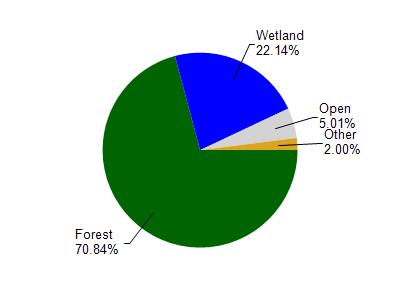Douglas
No
No
No
Fish and Aquatic Life
Overview
Source: 1973, Surface Water Resources of Douglas County
Thorne Lake, T43N, R10W. Section 7. 8.
Surface Acres-29.4, Maximum Depth-9 feet, M.P.A.-8 ppm, Secchi
Disk-Bottom
A soft water seepage lake, it is landlocked and subject to
occasional partial winterkills of the fishery. The present fish
population consists of northern pike, largemouth bass, perch. blue-
gills, and a few black crappies. pumpkinseeds. and bullheads.
Water level fluctuations of at least two feet of lake depth occur
in some years. and are partly responsible for the winter freeze-
out conditions. The water transparency is clear. and the lake's
littoral bottom along shore is sandy, with some gravel and muck in
the south bay. The south shore is bordered by sedge meadow and a
leatherleaf bog of 13 acres. These wetlands provide nesting
habitat for mallards, blue-winged teal, and wood ducks, although
the lake is not especially noted for waterfowl hunting. The
remaining shore is upland with Jack pine and mixed hards. Private
development amounts to two cottages. The only public frontage is a
60-foot wide undeveloped platted access on the lake's north end.
There is presently no developed access road.
Date
Author Aquatic Biologist
Condition
Wisconsin has over 84,000 miles of streams, 15,000 lakes and milllions of acres of wetlands. Assessing the condition of this vast amount of water is challenging. The state's water monitoring program uses a media-based, cross-program approach to analyze water condition. An updated monitoring strategy (2015-2020) is now available. Compliance with Clean Water Act fishable, swimmable standards are located in the Executive Summary of Water Condition in 2018. See also the 'monitoring and projects' tab.
Reports
Management Goals
Wisconsin's Water Quality Standards provide qualitative and quantitative goals for waters that are protective of Fishable, Swimmable conditions [Learn more]. Waters that do not meet water quality standards are considered impaired and restoration actions are planned and carried out until the water is once again fishable and swimmable
Management goals can include creation or implementation of a Total Maximum Daily Load analysis, a Nine Key Element Plan, or other restoration work, education and outreach and more. If specific recommendations exist for this water, they will be displayed below online.
Monitoring
Monitoring the condition of a river, stream, or lake includes gathering physical, chemical, biological, and habitat data. Comprehensive studies often gather all these parameters in great detail, while lighter assessment events will involve sampling physical, chemical and biological data such as macroinvertebrates. Aquatic macroinvertebrates and fish communities integrate watershed or catchment condition, providing great insight into overall ecosystem health. Chemical and habitat parameters tell researchers more about human induced problems including contaminated runoff, point source dischargers, or habitat issues that foster or limit the potential of aquatic communities to thrive in a given area. Wisconsin's Water Monitoring Strategy was recenty updated.
Grants and Management Projects
| Project Name (Click for Details) | Year Started |
|---|
|
|
Monitoring Projects
| WBIC | Official Waterbody Name | Station ID | Station Name | Earliest Fieldwork Date | Latest Fieldwork Date | View Station | View Data |
|---|
| 2501300 | Thorn Lake | 10002198 | Thorn Lake | 9/5/2000 | 9/15/2012 | Map | Data |
| 2501300 | Thorn Lake | 164013 | Thorn Lake - Thorn Lake | 7/19/1979 | 7/19/1979 | Map | Data |
|

Watershed Characteristics
Thorn Lake is located in the Totagatic River watershed which is 329.93 mi². Land use in the watershed is primarily forest (70.70%), wetland (22.10%) and a mix of open (5%) and other uses (2.00%). This watershed has 275.08 stream miles, 6,681.38 lake acres and 42,970.25 wetland acres.
Nonpoint Source Characteristics
This watershed is ranked Not Ranked for runoff impacts on streams, Not Ranked for runoff impacts on lakes and Low for runoff impacts on groundwater and therefore has an overall rank of Low. This value can be used in ranking the watershed or individual waterbodies for grant funding under state and county programs.However, all waters are affected by diffuse pollutant sources regardless of initial water quality. Applications for specific runoff projects under state or county grant programs may be pursued. For more information, go to surface water program grants.